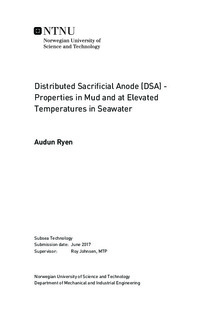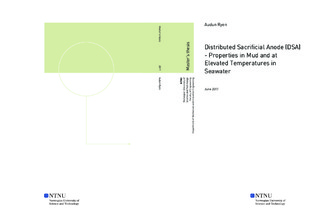| dc.description.abstract | Cost savings with regards to optimizing the Cathodic Protection (CP) design has over the last 50 years not been considered as a major opportunity so far. Sacrificial anodes combined with organic coatings is the main corrosion protection strategy per now for subsea applications. Much experience from this method has been gained, but some limitations exist. The total anode mass can be significant, depending on the size, complexity, environmental conditions and design life of the subsea system. The total anode mass adds weight to the submerged structure. This can cause constraints on installation vessels and cranes, causing increased installation costs. Decreasing the weight on CP system can reduce costs by using less costly installation vessels, and could also favor safer installation campaigns due to less complex lift operations.
A fairly new concept was tested in this study. The concept is named Distributed Sacrificial Anode (DSA) and consists of distributing sacrificial anodes from an anode alloy (Al-Zn-In) onto Carbon Steel (CS) plates. This was in this study achieved by electric arc spraying, a thermal spraying process. The idea behind this solution is to reduce the total anode mass required, since the coating itself may provide sufficient CP to CS during lifetime.
The electrochemical properties of DSA at elevated temperatures in natural SW was examined in this study. The experiments were performed in rebuilt glass beakers containing natural SW. SW was replaced with fresh SW at certain intervals to prevent the samples from being exposed to the same electrolyte throughout exposure. Identical tests, including freely exposed and galvanically coupled (with CS) DSA, Thermally Sprayed Aluminum (TSA) (99.5\% Al) and Anode (Al-Zn-In) samples, were performed at three temperatures; 22, 50 and 80°C, respectively. The electrochemical properties of DSA at exposure in saline mud was also examined in this study. The experiment was performed in a container with mud taken from the shoreline outside Statoil Rotvoll, Trondheim. DSA and TSA samples were freely exposed, galvanically coupled with CS and polarized to -1.1 V Ag/AgCl in mud.
The anodic abilities of coatings were investigated and compared. The effect of temperature in SW and exposure in mud on the electrochemical properties was one of the main focus areas, and it was attempted to quantify the effect of temperature on total degradation of the coatings.
This thesis discovered that the electrochemical properties of DSA are similar to those of a sacrificial anode. The results showed that DSA worked better as a CP system, providing increased level of protection to CS at all temperatures compared to TSA. This is overall because DSA contains elements of Zinc and Indium, that activate the Aluminum substrate. Freely exposed DSA and TSA samples suffer initially from high corrosion rates at elevated temperatures, but they decrease rapidly during exposure. No significant difference in corrosion rates as a function of temperature was found after 2 months of exposure, the corrosion rates were in fact slightly lower with increased temperature. It was found that TSA and DSA embedded in mud exhibit low corrosion rates throughout exposure. DSA had active anodic abilities which ensured increased level of protection of CS in mud compared to TSA. It was found that DSA requires slightly less current density compared to TSA when cathodically polarized to -1100 mV Ag/AgCl in mud.
The results obtained in this thesis showed that crevice corrosion is an increasing threat at elevated temperatures in SW both for coupled TSA and DSA samples. Coupled DSA samples at all temperatures in SW appear to suffer from cohesive failure. Quantifying the effect of temperature on total degradation of DSA and TSA samples can not be done solely based on the findings in this report. | |

